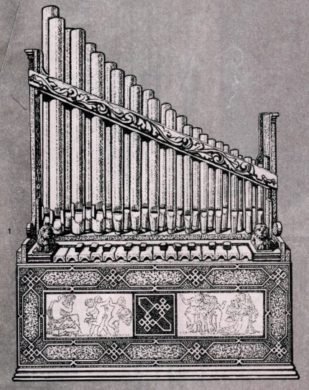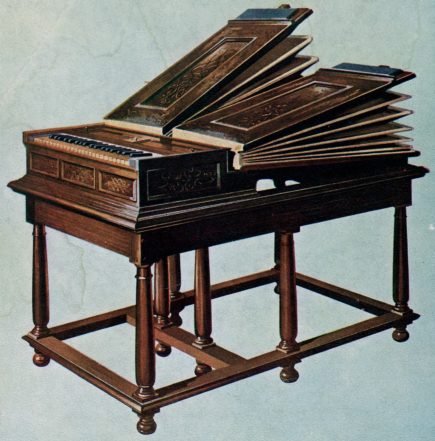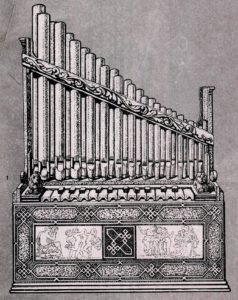The Piano Key Notes Were First
Applied To These Instruments
It is generally assumed that the black and white pattern of piano key notes is directly linked to the invention of the harpsichord, clavichord and the pianoforte.
 But what many don’t realize is that the piano key layout was already in existence 2000 years before there was ever such a thing as a piano.
But what many don’t realize is that the piano key layout was already in existence 2000 years before there was ever such a thing as a piano.
So while Bartolomeo Cristofori is the noted inventor of the pianoforte around the year 1709, the one thing Cristofori did not invent was the actual piano note chart itself.
In order to discover its true origins and learn who was actually responsible for the early development of the piano key chart we must go back more than two millennia, even before the birth of Christ and revisit the very first keyboard instrument ever to exist.
The Hydraulis
The Hydraulis was the oldest ancestor of the modern day church organ and the first musical instrument to utilize a system of manually operated piano key notes. A Greek engineer named Ctesibius of Alexandria was the inventor of this ancient keyboard instrument in 250 BC.
Ctesibius drew his inspiration for the Hydraulis from an even more distant musical instrument… the panpipes (which originated in China around 2000 BC).
 Whereas a panpipe can only play one flute (one tone) at a time, Ctesibius wanted to create a pipe instrument that could play different flutes (tones) at the same time.
Whereas a panpipe can only play one flute (one tone) at a time, Ctesibius wanted to create a pipe instrument that could play different flutes (tones) at the same time.
Using 3rd century BC technology, the pipes of the Hydraulis utilized an air compression mechanism that was powered by water (water means: hýdor in Greek). Like modern pipe organs of today, each pipe of the Hydraulis was tuned to a specific tone or “note”.
Water and air pressure would build up in a wind chamber. When the wooden keys were pressed, air would be squeezed through a wind-trunk leading up into a network of pipes (producing sound).
To prevent water from rushing up into the pipes, two special “splash plates” prevented the water from escaping into the wind-trunk.
Eventually the water-driven mechanism would be replaced with a totally air-driven “bellows” system that pumped the air by hand.
The keyboard structure of the Hydraulis was similar to today’s piano key layout in one way: the lower (bass) notes were situated on the left, and higher (treble) notes were situated on the right.
Although the piano key notes of the Hydraulis consisted only of seven basic notes (A, B, C, D, E, F, & G), it was a very popular and sought after form of musical entertainment in Greece and Rome during the first five centuries AD.
In 1992, Greek archeologists discovered the upper portion of a two thousand year old Hydraulis instrument in the city of Dion, Greece.
Based on ancient Greek literature, mosaics and sculptures depicting the instrument, members from the European Cultural Center of Delphi were able to reconstruct a modern-day version of the Hydraulis in 1999.
The Medieval Organ Family


Thought of as a symbol of wealth and prestige, this early organ was often gifted to royalty and emperors. Its image was engraved onto coins and could be heard playing at important events, festivals, and even during the combat games in the Roman amphitheatres.
However, after the Hydraulis was introduced to the western Catholic Church during the eight century AD, it would slowly evolve into a musical instrument with an entirely different appearance and an updated piano key layout.
The middle ages produced three distinctive church organ designs which where the first keyboard instruments to use all twelve piano key notes (A, A#, B, C, C#, D, D#, E, F, F#, G, & G#).
Positive Organ


Positive organs created sound with the use of air-powered “flue pipes” and a hand operated “bellows” pumping system.
The bellows were situated on the back of the organ, which required a second person to stand behind the instrument and pump the air supply needed to build up pressure.
When the organist pressed the wooden piano key notes, air would be dispensed into the flue pipes (each tuned to a specific tone), thereby producing the sound.
Portative Organ


This portable keyboard instrument was light enough to be carried around and played by one person.
The organ player could comfortably sit beside it and pump the bellows with his left hand while playing the piano note chart with his right hand.
Due to their inability to mechanically regulate air pressure, portative organs were a bit trickier to operate efficiently.
A portative organ player needed to have an experienced bellowing hand to control the flow of air pressure and produce a consistent level of pitch as he played the piano key layout. Too much or too little air supply would adversely affect the intonation of the piano key notes.
Regal Organ


Like a positive organ, it incorporated two bellows that needed to be operated by a second person.
But, unlike the positive or portative organs, the bible regal utilized a system of reeds to produce sound instead of flue pipes.
As air was pumped into the regal organ, the internal beating reeds produced more of a “snarling” sound as the piano key notes were played.
This added extra “flavor” to the music of that time and was a sharp contrast to the gentle sounding portative and positive organ models.
Bible regals were duly named because they could be taken apart, folded up and placed in a case resembling a large bible. Its small size was suitable for small chapels and yet affordable enough for moderate households of that time.
The Next Generation of Piano Keyboards


Italy would go on to invent the next generation of bowed stringed instruments, known today as the violin family. But it was the strings of an even more ancient instrument that would influence future keyboard designs.
Since the early days of the Hydraulis, the piano note chart had evolved from only seven piano key notes into the 12-note pattern used in modern music today. But at some point during the early 1400’s in European history, somebody (I’m guessing a harp player) finally said:
“Hey, let’s take the piano key layout of a church organ and attach it to the strings of a harp!”
This decision would lead to the beginning of a long line of ever evolving stringed keyboard instruments that would eventually lead up to the final design of the modern piano by the late 19th century.


Until one day… soon after the early 21st century, new and innovative teaching methodologies were developed. Lesson materials were updated and introduced as “user-friendly” alternatives to the much more strenuous musical works of the great old masters.
What was once thought of as a highly elite and advanced field of study would no longer be the sole realm of a few “gifted” individuals. Now people from all walks of life could enjoy and attain the gift of learning music due to this radically different approach to learning the piano…
The Piano Key Notes Were First
Applied To These Instruments
It is generally assumed that the black and white pattern of piano key notes is directly linked to the invention of the harpsichord, clavichord and the pianoforte.


So while Bartolomeo Cristofori is the noted inventor of the pianoforte around the year 1709, the one thing Cristofori did not invent was the actual piano note chart itself.
In order to discover its true origins and learn who was actually responsible for the early development of the piano key chart we must go back more than two millennia, even before the birth of Christ and revisit the very first keyboard instrument ever to exist.
The Hydraulis
The Hydraulis was the oldest ancestor of the modern day church organ and the first musical instrument to utilize a system of manually operated piano key notes. A Greek engineer named Ctesibius of Alexandria was the inventor of this ancient keyboard instrument in 250 BC.
Ctesibius drew his inspiration for the Hydraulis from an even more distant musical instrument… the panpipes (which originated in China around 2000 BC).



Using 3rd century BC technology, the pipes of the Hydraulis utilized an air compression mechanism that was powered by water (water means: hýdor in Greek). Like modern pipe organs of today, each pipe of the Hydraulis was tuned to a specific tone or “note”.
Water and air pressure would build up in a wind chamber. When the wooden keys were pressed, air would be squeezed through a wind-trunk leading up into a network of pipes (producing sound).
To prevent water from rushing up into the pipes, two special “splash plates” prevented the water from escaping into the wind-trunk.
Eventually the water-driven mechanism would be replaced with a totally air-driven “bellows” system that pumped the air by hand.
The keyboard structure of the Hydraulis was similar to today’s piano key layout in one way: the lower (bass) notes were situated on the left, and higher (treble) notes were situated on the right.
Although the piano key notes of the Hydraulis consisted only of seven basic notes (A, B, C, D, E, F, & G), it was a very popular and sought after form of musical entertainment in Greece and Rome during the first five centuries AD.
In 1992, Greek archeologists discovered the upper portion of a two thousand year old Hydraulis instrument in the city of Dion, Greece.
Based on ancient Greek literature, mosaics and sculptures depicting the instrument, members from the European Cultural Center of Delphi were able to reconstruct a modern-day version of the Hydraulis in 1999.
The Medieval Organ Family
During the first few centuries AD, the Hydraulis was a favorite instrument among the ancient Greeks and the Roman Empire.


Its image was engraved onto coins and could be heard playing at important events, festivals, and even during the combat games in the Roman amphitheatres.
However, after the Hydraulis was introduced to the western Catholic Church during the eight century AD, it would slowly evolve into a musical instrument with an entirely different appearance and an updated piano key layout.
The middle ages produced three distinctive church organ designs which where the first keyboard instruments to use all twelve piano key notes (A, A#, B, C, C#, D, D#, E, F, F#, G, & G#).
Positive Organ


Positive organs created sound with the use of air-powered “flue pipes” and a hand operated “bellows” pumping system.
The bellows were situated on the back of the organ, which required a second person to stand behind the instrument and pump the air supply needed to build up pressure.
When the organist pressed the wooden piano key notes, air would be dispensed into the flue pipes (each tuned to a specific tone), thereby producing the sound.
Portative Organ


This portable keyboard instrument was light enough to be carried around and played by one person.
The organ player could comfortably sit beside it and pump the bellows with his left hand while playing the piano note chart with his right hand.
Due to their inability to mechanically regulate air pressure, portative organs were a bit trickier to operate efficiently.
A portative organ player needed to have an experienced bellowing hand to control the flow of air pressure and produce a consistent level of pitch as he played the piano key layout. Too much or too little air supply would adversely affect the intonation of the piano key notes.
Regal Organ


Like a positive organ, it incorporated two bellows that needed to be operated by a second person.
But, unlike the positive or portative organs, the bible regal utilized a system of reeds to produce sound instead of flue pipes.
As air was pumped into the regal organ, the internal beating reeds produced more of a “snarling” sound as the piano key notes were played.
This added extra “flavor” to the music of that time and was a sharp contrast to the gentle sounding portative and positive organ models.
Bible regals were duly named because they could be taken apart, folded up and placed in a case resembling a large bible. Its small size was suitable for small chapels and yet affordable enough for moderate households of that time.
The Next Generation of Piano Keyboards
As the middle ages of European history came to a close, the dawn of the renaissance would soon arise and awaken a renewed interest in science, art and music.


Since the early days of the Hydraulis, the piano note chart had evolved from only seven piano key notes into the 12-note pattern used in modern music today. But at some point during the early 1400’s in European history, somebody (I’m guessing a harp player) finally said:
“Hey, let’s take the piano key layout of a church organ and attach it to the strings of a harp!”
This decision would lead to the beginning of a long line of ever evolving stringed keyboard instruments that would eventually lead up to the final design of the modern piano by the late 19th century.


Until one day… soon after the early 21st century, new and innovative teaching methodologies were developed. Lesson materials were updated and introduced as “user-friendly” alternatives to the much more strenuous musical works of the great old masters.
What was once thought of as a highly elite and advanced field of study would no longer be the sole realm of a few “gifted” individuals. Now people from all walks of life could enjoy and attain the gift of learning music due to this radically different approach to learning the piano…
The Piano Key Notes Were First Applied To These Instruments


It is generally assumed that the black and white pattern of piano key notes is directly linked to the invention of the harpsichord, clavichord and the pianoforte.
But what many don’t realize is that the piano key layout was already in existence 2000 years before there was ever such a thing as a piano.
So while Bartolomeo Cristofori is the noted inventor of the pianoforte around the year 1709, the one thing Cristofori did not invent was the actual piano note chart itself.
In order to discover its true origins and learn who was actually responsible for the early development of the piano key chart we must go back more than two millennia, even before the birth of Christ and revisit the very first keyboard instrument ever to exist.
The Hydraulis
The Hydraulis was the oldest ancestor of the modern day church organ and the first musical instrument to utilize a system of manually operated piano key notes.
A Greek engineer named Ctesibius of Alexandria was the inventor of this ancient keyboard instrument in 250 BC.
Ctesibius drew his inspiration for the Hydraulis from an even more distant musical instrument… the panpipes (which originated in China around 2000 BC).


Whereas a panpipe can only play one flute (one tone) at a time, Ctesibius wanted to create a pipe instrument that could play different flutes (tones) at the same time.
Using 3rd century BC technology, the pipes of the Hydraulis utilized an air compression mechanism that was powered by water (water means: hýdor in Greek).
Like modern pipe organs of today, each pipe of the Hydraulis was tuned to a specific tone or “note”.
Water and air pressure would build up in a wind chamber. When the wooden keys were pressed, air would be squeezed through a wind-trunk leading up into a network of pipes (producing sound).
To prevent water from rushing up into the pipes, two special “splash plates” prevented the water from escaping into the wind-trunk.
Eventually the water-driven mechanism would be replaced with a totally air-driven “bellows” system that pumped the air by hand.
The keyboard structure of the Hydraulis was similar to today’s piano key layout in one way: the lower (bass) notes were situated on the left, and higher (treble) notes were situated on the right.
Although the piano key notes of the Hydraulis consisted only of seven basic notes (A, B, C, D, E, F, & G), it was a very popular and sought after form of musical entertainment in Greece and Rome during the first five centuries AD.
In 1992, Greek archeologists discovered the upper portion of a two thousand year old Hydraulis instrument in the city of Dion, Greece.
Based on ancient Greek literature, mosaics and sculptures depicting the instrument, members from the European Cultural Center of Delphi were able to reconstruct a modern-day version of the Hydraulis in 1999.
The Medieval Organ Family
During the first few centuries AD, the Hydraulis was a favorite instrument among the ancient Greeks and the Roman Empire.
Thought of as a symbol of wealth and prestige, this early organ was often gifted to royalty and emperors.
Its image was engraved onto coins and could be heard playing at important events, festivals, and even during the combat games in the Roman amphitheatres.


However, after the Hydraulis was introduced to the western Catholic Church during the eight century AD, it would slowly evolve into a musical instrument with an entirely different appearance and an updated piano key layout.
The middle ages produced three distinctive church organ designs which where the first keyboard instruments to use all twelve piano key notes (A, A#, B, C, C#, D, D#, E, F, F#, G, & G#).
Positive Organ
The positive organ (also known as the “chamber organ”) was the largest organ model during the middle ages, and was designed for either church or home use.


Positive organs created sound with the use of air-powered “flue pipes” and a hand operated “bellows” pumping system.
The bellows were situated on the back of the organ, which required a second person to stand behind the instrument and pump the air supply needed to build up pressure.
When the organist pressed the wooden piano key notes, air would be dispensed into the flue pipes (each tuned to a specific tone), thereby producing the sound.
Portative Organ
The portative organ was a smaller flue pipe organ that was made between the 12th and 17th centuries.


This portable keyboard instrument was light enough to be carried around and played by one person.
The organ player could comfortably sit beside it and pump the bellows with his left hand while playing the piano note chart with his right hand.
Due to their inability to mechanically regulate air pressure, portative organs were a bit trickier to operate efficiently.
A portative organ player needed to have an experienced bellowing hand to control the flow of air pressure and produce a consistent level of pitch as he played the piano key layout. Too much or too little air supply would adversely affect the intonation of the piano key notes.
Regal Organ
The regal organ (also known as the “bible regal”) was a small, portable table organ that came into use by the end of the medieval time period.


Like a positive organ, it incorporated two bellows that needed to be operated by a second person.
But, unlike the positive or portative organs, the bible regal utilized a system of reeds to produce sound instead of flue pipes.
As air was pumped into the regal organ, the internal beating reeds produced more of a “snarling” sound as the piano key notes were played.
This added extra “flavor” to the music of that time and was a sharp contrast to the gentle sounding portative and positive organ models.
Bible regals were duly named because they could be taken apart, folded up and placed in a case resembling a large bible. Its small size was suitable for small chapels and yet affordable enough for moderate households of that time.
The Next Generation of Piano Keyboards
As the middle ages of European history came to a close, the dawn of the renaissance would soon arise and awaken a renewed interest in science, art and music.
Italy would go on to invent the next generation of bowed stringed instruments, known today as the violin family. But it was the strings of an even more ancient instrument that would influence future keyboard designs.


Since the early days of the Hydraulis, the piano note chart had evolved from only seven piano key notes into the 12-note pattern used in modern music today.
But at some point during the early 1400’s in European history, somebody (I’m guessing a harp player) finally said:
“Hey, let’s take the piano key layout of a church organ and attach it to the strings of a harp!”
This decision would lead to the beginning of a long line of ever evolving stringed keyboard instruments that would eventually lead up to the final design of the modern piano by the late 19th century.


And although the appearance of the “pianoforte” would transform significantly since the early 1700’s, the tradition of classical music theory remained the standard curriculum for learning the piano key notes well into the 20th century.
Until one day… soon after the early 21st century, new and innovative teaching methodologies were developed. Lesson materials were updated and introduced as “user-friendly” alternatives to the much more strenuous musical works of the great old masters.
What was once thought of as a highly elite and advanced field of study would no longer be the sole realm of a few “gifted” individuals.
Now people from all walks of life could enjoy and attain the gift of learning music due to this radically different approach to learning the piano…
